Edward Avedisian John Opper, Larry Zox | Hard-Edged Geometric Abstraction, Upsilon Gallery, New York
June 29, 2022 - Upsilon Gallery
Hard-Edged Geometric Abstraction
Upsilon Gallery, New York
June 24 - July 30, 2022
More Information
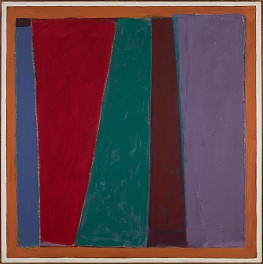
June 29, 2022 - Upsilon Gallery
Hard-Edged Geometric Abstraction
Upsilon Gallery, New York
June 24 - July 30, 2022
More Information

October 9, 2020 - Roberta Smith for The New York Times
ART REVIEW
A Gallery Resurgence in Chelsea
In the face of economic unknowns, the message from the city’s galleries is: we’re not taking this lying down. Roberta Smith on 16 of the neighborhood’s most riveting painting shows.
By Roberta Smith
After several months of forced inactivity because of the pandemic, New York’s art galleries are back, with a vengeance. Since Labor Day, they have collectively mustered one of the better fall seasons of the last several years, with more to come in the weeks ahead. Yes, there have been changes. Unfortunately, some galleries have closed, while others are being worryingly slow to reopen. Yet fewer have gone missing than seemed likely in March or April. Others have sought new leases on life by relocating from Chelsea to TriBeCa, or from SoHo to the Upper East Side, and so forth.
In the face of the economic unknowns, the collective message from galleries sounds something like: we’re not taking this lying down.
The sense of resurgence is especially tangible in Chelsea, where my running list of shows to see has reached 74. A good number form a fractious conversation about painting.
The differing viewpoints about the medium can be dizzying, ricocheting off each other. They range from Pieter Schoolwerth’s demonically choreographed “Shifted Sims” series at Petzel Gallery — where figures and interiors from the Sims video games, printed on canvas, intersect with mannered applications of paint, forming a disturbing netherworld of social and art-making rituals — to Julian Schnabel’s latest forays into Romantic abstraction at Pace. In them, great flourishes of white and blue unfurl across slightly shaped stretchers with a dusty pink tarp serving as canvas. And they are bookended by shows of crisp new Minimalist paintings from Robert Mangold, and Yoshitomo Nara’s unendingly cute, wide-eyed innocents, brought forth with consummate ease in paint and colored pencil.
Mr. Schoolwerth’s fastidious craft finds some echo in Kyle Dunn’s work at P.P.O.W., where the paintings build on the homoerotic realism of Paul Cadmus and the stylized figuration of Tamara de Lempicka — once-overlooked talents of the 1930s. His beautifully carved wood frames ripple around and sometimes interrupt the images.
At Berry Campbell you can see the all-but-forgotten fusion of Minimalist boldness and Color Field staining that Edward Avesidian achieved in the mid-1960s. And Michael Rosenfeld Gallery has brought together a large, stunning group of Benny Andrews’s portraits primarily from the 1970s and ’80s which have not been seen together before. The psychological realness of Mr. Andrews’s Black subjects contrasts strikingly with the more polemical go-for-the jugular approach of a younger generation exemplified by the strong new paintings in Titus Kaphar’s first show at Gagosian, two blocks away.
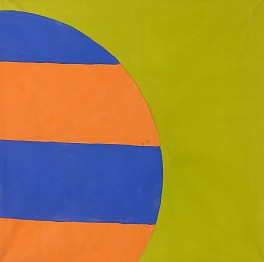
October 3, 2020 - Franklin Einspruch for Delicious Line
Edward Avedisian: Reverberations
Berry Campbell
Reviewed by Franklin Einspruch
Too sloppy to be hard-edge but too crisp to be painterly - could we call them medium-edge? - the 1965 paintings of Edward Avedisian infuse Pop irreverence into a mode of painting that Darby Bannard called presentational abstraction, as if the art object "was staring right back at you like it was another person."
The compositional motif throughout the series is a striped ball or two sailing through the eighty-inch-plus color field. I was once an avid juggler and I am all but helpless with glee in front of these paintings. Nevertheless a few examples stand out. The orange and blue ball on the green background (all are untitled) hits an especially good color balance, with both the orange and the green reading as light. The orange and yellow ball on the burgundy background gets great mileage out of the staining effect of the acrylic. The "medium" of "medium-edge" would work as a double entendre, as the spill of paint past the drawn lines creates transparencies of color that turn these simple arrangements into pictures. Are they staring back, or am I?
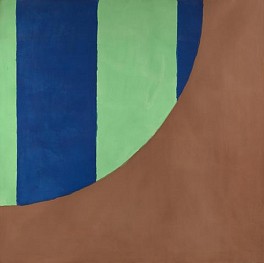
September 29, 2020
AVEDISIAN AT BERRY CAMPBELL: JUST WHAT THE DOCTOR ORDERED
September 26, 2020
By: Piri Halasz
Edward Avedisian (1936-2007) wasn't in "Post-Painterly Abstraction," the landmark show organized by Clement Greenberg in 1962. He is, however, included in "Clement Greenberg: A Critic's Collection," the catalogue of work owned by the late critic and acquired by the Portland Art Museum in 2000. And, like other, better-known color-field painters, Avedisian evidently understood the importance of making beautiful art that can offer balm to the wounded soul even –or perhaps especially -- in the most trying times.
The twelve paintings in this show date from 1963 to 1965. This was a period wracked by Vietnam, the first upheavals of the civil rights movement, and the assassination of JFK. And so this show comes like just what the doctor ordered in this equally if not more messed-up, politically toxic and disease-ridden New York moment of 2020.
Go and feast your eyes on "Edward Avedisian: Reverberations" at Berry Campbell (through October 10). It will let you take a trip for a few brief moments out of the here and now..and will therefore allow you to return, refreshed & reinvigorated, to do whatever you think may need to be done with redoubled zeal.
I confess that Avedisian's name wasn't familiar to me when I walked into this show. With the aid of the gallery's literature (as well as a bit of help from the web) I can report that he was born in Lowell, Massachusetts, and studied at the School of the Museum of Fine Arts, Boston. After having had at least one show in the Boston area, he moved to New York in the late '50s.
There he studied a bit more (at the School of Visual Arts), and became involved with the adult New York art scene. He was part of a whole younger generation of abstract artists: near-contemporaries included Darby Bannard (1934-2016), Frank Stella (b. 1936), and Larry Poons (b. 1937). From what l can tell, it seems that Avedisian's initial abstractions were painterly, in the tradition of first-generation abstract expressionism, and only became post-painterly later on.
He had a show in 1958 at the short-lived Hansa Gallery. Though it's not clear to me what kind of work he showed, the gallery was under the direction of Richard Bellamy & Ivan Karp, two live wires on the neo-Dada, pop-art front.
The Berry Campbell literature suggests that Avedisian combined the "hot" colors of pop with the "cool, more analytical qualities of Color Field painting." Certainly, Avedisian's colors are bright, but I don't see any further analogies with the limited and coloristically obvious palette of the likes of Warhol, Wesselman, Rosenquist or Lichtenstein.
Rather, I find most of Avedisian's colors far more varied & sophisticated than pop-art colors—fortunately (as far as I'm concerned).
All of these paintings are about circles, and of course circles are richly allusive: they are reminiscent of everything from suns, moon and stars to faces and bouncing balls – even (to be a little anachronistic) emojis.
These shapes are not only allusive but also wonderfully cheerful.
And there seems to be a sort of progression in this show from paintings with two, three or five little balls – decorated in various ways --- to paintings with just one.
The balls in the paintings with one ball in them are striped, like beach balls. The biggest canvas, a majestic horizontal in deep purple, has only a small ball floating near its lower edge – this ball is striped with a lighter purple and orange. It is a very impressive work.
But I guess my real favorites are the ones where the balls grow big, big and bigger, until they outgrow the canvas and only a portion of them can be shown---like the moon coming over a mountain.
There are five of these paintings in all, including one right at the entrance, one in the first gallery space, one (a smaller watercolor) in the central space, and two at the very back of the gallery.
The one I have chosen to reproduce hangs on the southernmost gallery wall. Here the circle has grown so big that only a quarter of it can be shown. The circle has navy blue and lime green vertical stripes, while the field that it dominates is a rich cinnamon brown. And the stripes descend from the top of the painting, making the ball look impossibly large and imposing.
But what is it, really? The moon seen through a powerful telescope? Or the ocean seen through a periscope? The magic of abstraction is it can be all of these – or none.
September 15, 2020 - NYC Gallery Openings
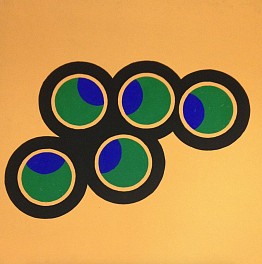
February 25, 2020 - Kim Uchiyama for Two Coats of Paint
Contributed by Kim Uchiyama / “Specific Forms” at Loretta Howard Gallery illuminates a particular moment in 20th century art history where works created by a variety of artists occupied the space between the then diverging ideologies of a young Donald Judd and those of the older critic Clement Greenberg. Saul Ostrow has curated a finely-tuned exhibit that demonstrates the highly individual modes of thought that were at play during this transitional time, ideas distinct from the critical positions of Minimalism, Pop and Color-field.
The movement known as Abstract Expressionism – a “movement” itself comprised of highly individualistic artists – can be seen in retrospect as the physical and psychological response to the global tensions of World War II. Mary Gabriel, in Ninth Street Women, her invaluable contribution to understanding the full scope of this era, emphasizes the war – and the lead up to war – as the underpinning for the formation of a new American art which would reflect the exigencies of the moment. The works in “Specific Forms” came about because these times had changed. Post-war America lacked the angst of the 1940s and 1950s, and was increasingly replaced in the 1960s and 1970s by an art that sought to look to itself reflexively, on its own terms – the thing being the thing itself.
In an era characterized by an implicit questioning of authority and established norms, these fourteen artists sought to break the mold of existing “-isms” and are seemingly preoccupied in creating a new consciousness via their art. The resulting works are highly specific unto themselves and characterized by strikingly individualistic terms for their existence.
Read More >>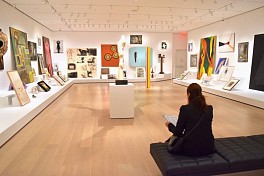
October 11, 2019 - artnet News
The Museum of Modern Art is set to reopen after its big expansive and restoration—and when it does, it’s crown jewels, the permanent collection will be reimagined. Old hits are still there, but new discoveries are also worked in. Film and architecture are integrated into the galleries. And the curation, as the New York Times reported, seeks to make room for “detours, anachronisms and surprise encounters.”
As the public gets ready for the new MoMA, here are photos that give a sense of how its new art history fits together.
Image: Ben Davis
Read More >>
November 7, 2013
NEW YORK, NEW YORK, November 8, 2013 – BERRY CAMPBELL is pleased to announce the November 21st opening of Edward Avedisian: The Soho Years, presenting nineteen vibrantly colored paintings and works on paper. The Soho Years will feature works painted between the early 1960s and 70s when Avedisian was living and working in the Soho neighborhood of New York. These abstract works such as his biomorphic forms, striped orbs, and stripes with splashes were prominently featured in Artforum (including the magazine’s cover in January 1969), Artnews, and Arts magazines.
Read More >>